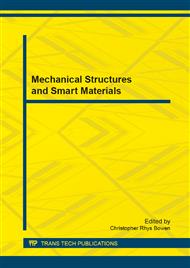[1]
Tian Hao. Electrorheological suspensions [J]. Advances in Colloid and Interface Science , 2002, 97: 1-35.
Google Scholar
[2]
Quoc-Hung Nguyen, Seung-Bok Choi. Dynamic modeling of an electrorheological damper considering the unsteady behavior of electrorheological fluid flow [J]. Smart Mater. Struct. 2009 , 18: 16-24.
DOI: 10.1088/0964-1726/18/5/055016
Google Scholar
[3]
Ping Sheng, Wei jia Wen. Electrorheology: Statics and dynamics [J]. Solid State Communications. 2010 , 150: 1023-1039.
DOI: 10.1016/j.ssc.2010.01.020
Google Scholar
[4]
A. Lukkarinen, K. Kaski. Simulation studies of electrorheological fluids under shear, compression, and elongation loading [J].J. Appl. Phys. 1998, 83: 1717-1725.
DOI: 10.1063/1.366890
Google Scholar
[5]
J. Kadaksham, P. Singh, N. Aubry. dynamics of Electrorheological Suspensions Subjected to Spatially Nonuniform Electric Fields [J]. Journal of Fluids Engineering, 2004, 126: 170-176.
DOI: 10.1115/1.1669401
Google Scholar
[6]
R. Tao. Structure and dynamics of dipolar fluids under strong shear [J]. Chemical Engineering Science. 2006, 61 (7) : 2186-2190.
DOI: 10.1016/j.ces.2004.02.022
Google Scholar
[7]
J.G. Cao, J.P. Huang, LWZhou. Structure of Electrorheological Fluids under an Electric Field and a Shear Flow: Experiment and Computer Simulation.J. Phys. Chem. B , 2006, 110: 11635-11639.
DOI: 10.1021/jp0611774
Google Scholar
[8]
Ladd A. J C. Numerical simulations of particulate suspensions via a discretized Boltzmann equation. Part 1. Theoretical foundation [J]. J Fluid Mech, 1994, 271: 285-309.
DOI: 10.1017/s0022112094001771
Google Scholar
[9]
Bouzidi M, Firdaouss M, Lallemand P. Momen tum transfer of a Boltzmann-lattice fluid with boundaries [J]. Phys Fluids, 2001, 13: 3452-3459.
DOI: 10.1063/1.1399290
Google Scholar
[10]
K. Han, YTFeng, DRJOwen. Coupled lattice Boltzmann and discrete element modelling of fluid-particle interaction problems [J]. Computers and Structures , 2007, 85: 1080-1088.
DOI: 10.1016/j.compstruc.2006.11.016
Google Scholar
[11]
Klingenberg D, van Swol F, Zukoski C. The small shear rate response of electrorheological suspensions. II. Extension beyond the point-dipole limit [J]. Journal of Chemical Physics 1991; 94: 6170 - 6178.
DOI: 10.1063/1.460403
Google Scholar
[12]
Zhao Yu, Liang-Shih Fan. Lattice Boltzmann method for simulating particle-fluid interactions [J]. Particuology. 2010 , 8: 539-543.
DOI: 10.1016/j.partic.2010.07.012
Google Scholar
[13]
Zhou GF, Wang LM, Wang X W. Direct numerical simulation scheme for particle-fluid systems based on a time-driven hard-sphere and the lattice Boltzmann method [J]. Chinese Sci Bull (Chinese Ver) . 2011, 56: 1246-1256.
DOI: 10.1360/972010-1687
Google Scholar
[14]
X.D. Niu, C. Shu, YTChew, Y. Peng. A momentum exchange-based immersed boundary-lattice Boltzmann method for simulating incompressible viscous flows [J]. Physics Letters A. 2006 , 354: 173-182.
DOI: 10.1016/j.physleta.2006.01.060
Google Scholar


